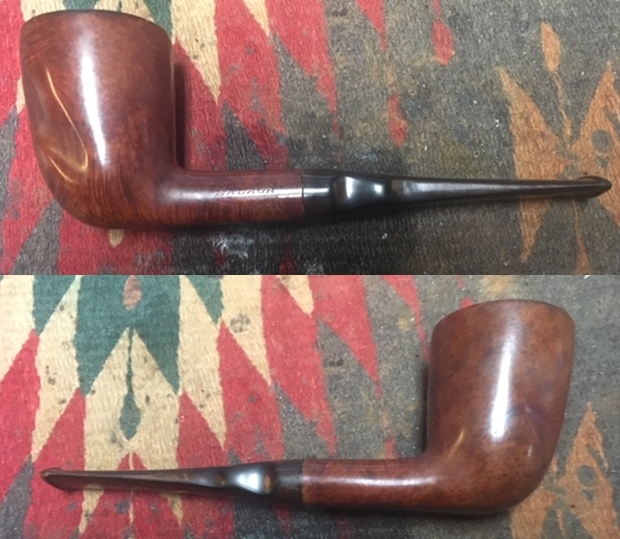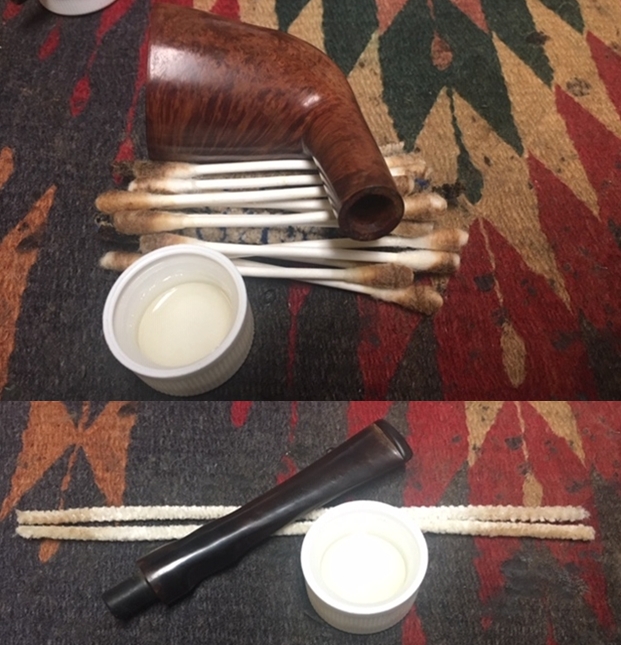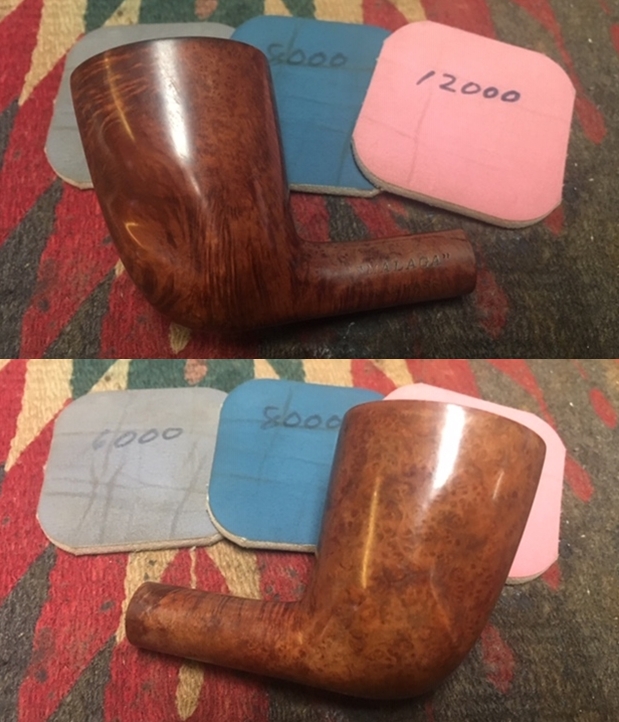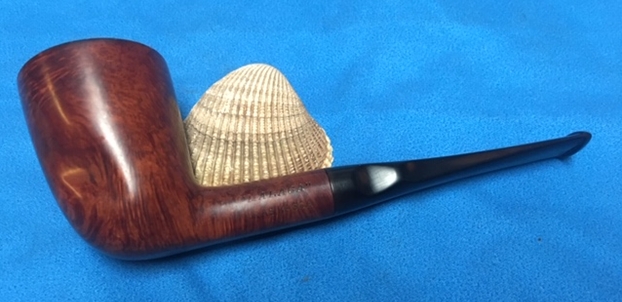Blog by Steve Laug
The next pipe in the queue is the last Malaga pipe from Alex’s batch.This is a “Malaga” Ras Kassa –a twisted carved Dublin. It has some amazing grain around the bowl that is carved to highlight the grain around the bowl and give the briar some playful carved twists. The pipe is stamped on the left side of the shank, “MALAGA” over RAS KASSA. The tapered vulcanite stem has notches and twists like the bowl. There is no marking or stamping on the stem. This is a second RAS KASSA from Alex and it is as nice as the previous one. I have included the link so you can check it out (https://rebornpipes.com/2019/05/23/rebirthing-a-malaga-ras-kassa-canadian/). The bowl had a medium cake in the chamber that was no problem. The rim top was really in rough condition. There was major burn damage on the rim top and the inner edge. The entire inner edge had been compromised. The outer edge had some darkening and burn damage as well particularly at the back of the bowl. The exterior of the briar was dusty with grime and dust. The stem had heavy, deep oxidation and deep tooth marks in the surface of the stem on both sides. The photos below tell the story and give a glimpse of the pipe before clean up. 
 I took a photo of the bowl and rim to capture the condition of the pipe before I started my cleanup work. You can see the extent of the damage to the inner edge of the rim and the rim top. The burn marks were quite deep and extensive. You can see the cake in the bowl and some of the lava on the rim top. The stem had deep oxidation on the surface of the vulcanite. There were deep tooth marks on the underside of the stem.
I took a photo of the bowl and rim to capture the condition of the pipe before I started my cleanup work. You can see the extent of the damage to the inner edge of the rim and the rim top. The burn marks were quite deep and extensive. You can see the cake in the bowl and some of the lava on the rim top. The stem had deep oxidation on the surface of the vulcanite. There were deep tooth marks on the underside of the stem. I also took a photo of top side of the shank from two angles to show the stamping. The stamping is readable in the photos below and is as noted above – “MALAGA” over RAS KASSA. It is stamped on the underside of the shank with the lower case “m”.
I also took a photo of top side of the shank from two angles to show the stamping. The stamping is readable in the photos below and is as noted above – “MALAGA” over RAS KASSA. It is stamped on the underside of the shank with the lower case “m”.
 For those of you who are unfamiliar with the brand, I am also including the link to a blog that I wrote that gives some of the history of the Malaga brand and the Malaga Pipe Shop in Royal Oak, Michigan in the USA. Here is the link – https://rebornpipes.com/tag/malaga-pipes/. That blog also includes links to a catalogue and the history of the pipemaker George Khoubesser. If you are interested to learn more then I invite you to follow the link to get a feel for the brand and the pipemaker.
For those of you who are unfamiliar with the brand, I am also including the link to a blog that I wrote that gives some of the history of the Malaga brand and the Malaga Pipe Shop in Royal Oak, Michigan in the USA. Here is the link – https://rebornpipes.com/tag/malaga-pipes/. That blog also includes links to a catalogue and the history of the pipemaker George Khoubesser. If you are interested to learn more then I invite you to follow the link to get a feel for the brand and the pipemaker.
I am also am including a link to some printed material on the Malaga brand that came to me from the daughter of George Koch to help identify the particular stamping on the pipe. The link takes you to the entire collection of materials that were sent to me. I have included a screen capture of one particular page that helps identify the RAS KASSA stamping on the pipe (https://rebornpipes.com/2019/02/27/malaga-pipes-catalogue-of-pipes-and-tobaccos/). I have enclosed the section on the brand in a red box in the picture above. To summarize, it basically says that the stamping is applied to pipes with special rare grain patterns in the briar. These appear to be straight grain, birdseye, swirled grains etc. that are tight patterns. They are rare – 1 or 2 in every hundred pipes. This pipe is one of those. You can read the description in the detailed explanation below.
I have enclosed the section on the brand in a red box in the picture above. To summarize, it basically says that the stamping is applied to pipes with special rare grain patterns in the briar. These appear to be straight grain, birdseye, swirled grains etc. that are tight patterns. They are rare – 1 or 2 in every hundred pipes. This pipe is one of those. You can read the description in the detailed explanation below.
I decided to address the damage to the rim top and edges first. I topped the bowl on a topping board using 220 grit sandpaper to remove the damaged portions of the rim surface. The second photo clearly shows the extent of the damage. I continued to top the bowl until the rim damage was removed and the inner and outer edges were clean.
 Once the damage was removed from the top of the bowl I used a folded piece of 220 grit sandpaper to clean up the inside edge of the bowl.
Once the damage was removed from the top of the bowl I used a folded piece of 220 grit sandpaper to clean up the inside edge of the bowl. I scrubbed the exterior of the bowl with Murphy’s Oil Soap and a cotton pad to remove the grime and build up on the surface of the briar. I rinsed the bowl down with warm water to remove the grime and soap. I dried the bowl off with a soft cotton cloth to dry it off.
I scrubbed the exterior of the bowl with Murphy’s Oil Soap and a cotton pad to remove the grime and build up on the surface of the briar. I rinsed the bowl down with warm water to remove the grime and soap. I dried the bowl off with a soft cotton cloth to dry it off.
 I reamed the bowl with a PipNet reamer with the second and third cutting head to take the cake back to bare briar. I cleaned it up with a Savinelli Fitsall Pipe Knife to get rid of the remnants of the cake. I finished by sanding the bowl with a dowel wrapped with 220 grit sandpaper until the inside of the bowl was smooth.
I reamed the bowl with a PipNet reamer with the second and third cutting head to take the cake back to bare briar. I cleaned it up with a Savinelli Fitsall Pipe Knife to get rid of the remnants of the cake. I finished by sanding the bowl with a dowel wrapped with 220 grit sandpaper until the inside of the bowl was smooth.
 With the bowl reamed, I cleaned up the inside of the shank and mortise with a pen knife to remove the tar build up. I ran cotton swabs, pipe cleaners and alcohol through the shank to remove the tars and oils. I also cleaned out the airway in the stem using pipe cleaners and alcohol.
With the bowl reamed, I cleaned up the inside of the shank and mortise with a pen knife to remove the tar build up. I ran cotton swabs, pipe cleaners and alcohol through the shank to remove the tars and oils. I also cleaned out the airway in the stem using pipe cleaners and alcohol.
 I polished the rim and the outside of the bowl with micromesh sanding pads – wet sanding with 1500-12000 grit micromesh sanding pads and wiped the bowl and shank down after each pad with a damp cloth. The photos show how the grain really stands out after polishing. I am pretty happy with the results.
I polished the rim and the outside of the bowl with micromesh sanding pads – wet sanding with 1500-12000 grit micromesh sanding pads and wiped the bowl and shank down after each pad with a damp cloth. The photos show how the grain really stands out after polishing. I am pretty happy with the results. 




 I worked Before & After Restoration Balm into the surface of the briar with my fingertips to clean, enliven and protect it. I worked it into the craving on the sides of the bowl to make sure I covered all of the grooves, nooks and crannies. I let the balm sit for a little while and then buffed with a cotton cloth to raise the shine.
I worked Before & After Restoration Balm into the surface of the briar with my fingertips to clean, enliven and protect it. I worked it into the craving on the sides of the bowl to make sure I covered all of the grooves, nooks and crannies. I let the balm sit for a little while and then buffed with a cotton cloth to raise the shine.

 With the bowl finished I set it aside and turned my attention to the stem. I sanded out the tooth chatter, marks and oxidation to clean up the look of the stem. I was able to remove the majority of the damage to the stem by sanding. The photos below show the stem after sanding. There was one tooth mark on the underside of the stem that I filled with clear super glue. I set the stem aside to cure.
With the bowl finished I set it aside and turned my attention to the stem. I sanded out the tooth chatter, marks and oxidation to clean up the look of the stem. I was able to remove the majority of the damage to the stem by sanding. The photos below show the stem after sanding. There was one tooth mark on the underside of the stem that I filled with clear super glue. I set the stem aside to cure.
 I sanded the repairs on the stem surface with 220 grit sandpaper to blend the repairs into the surface of the stem. I am happy with the stem surface once that was done. I started the polishing of the surface with 400 grit wet dry sandpaper.
I sanded the repairs on the stem surface with 220 grit sandpaper to blend the repairs into the surface of the stem. I am happy with the stem surface once that was done. I started the polishing of the surface with 400 grit wet dry sandpaper.  I polished the stem with micromesh sanding pads – wet sanding it with 1500-12000 grit pads. I wiped the stem down with a damp cloth after each pad. I further polished it with Before & After Pipe Polish – both Fine and Extra Fine. I wiped it down with a coat of Obsidian Oil and set it aside to dry.
I polished the stem with micromesh sanding pads – wet sanding it with 1500-12000 grit pads. I wiped the stem down with a damp cloth after each pad. I further polished it with Before & After Pipe Polish – both Fine and Extra Fine. I wiped it down with a coat of Obsidian Oil and set it aside to dry.
 I put the pipe back together and polished both the bowl and the stem with Blue Diamond polish on the buffing wheel. I gave the bowl and the stem multiple coats of carnauba wax. I buffed the pipe with a clean buffing pad to raise the shine. I hand buffed it with a microfiber cloth to deepen the shine. The pipe polished up pretty nicely. The oil cured finish and the grain came alive with the buffing. The grain really stands out against the oil cured finish providing a rich contrast. The finish on the briar works well with the polished black vulcanite stem. The finished pipe is a well-proportioned, nicely grained Dublin. Have a look at it with the photos below. The dimensions are Length: 5 3/4 inches, Height: 2 inches, Outside diameter of the bowl: 1 3/8 inches, Chamber diameter: 3/4 of an inch. This Malaga Ras Kassa Dublin will be going back to Alex to add to his rack of Malaga pipes that are in his collection. Thanks for walking through the restoration with me on another of Alex’s Malaga collection.
I put the pipe back together and polished both the bowl and the stem with Blue Diamond polish on the buffing wheel. I gave the bowl and the stem multiple coats of carnauba wax. I buffed the pipe with a clean buffing pad to raise the shine. I hand buffed it with a microfiber cloth to deepen the shine. The pipe polished up pretty nicely. The oil cured finish and the grain came alive with the buffing. The grain really stands out against the oil cured finish providing a rich contrast. The finish on the briar works well with the polished black vulcanite stem. The finished pipe is a well-proportioned, nicely grained Dublin. Have a look at it with the photos below. The dimensions are Length: 5 3/4 inches, Height: 2 inches, Outside diameter of the bowl: 1 3/8 inches, Chamber diameter: 3/4 of an inch. This Malaga Ras Kassa Dublin will be going back to Alex to add to his rack of Malaga pipes that are in his collection. Thanks for walking through the restoration with me on another of Alex’s Malaga collection. 












